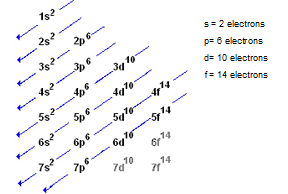
(a)
Interpretation:
The total number of electrons, valence electrons, group number, period and number of valence shell for carbon should be determined.
Concept Introduction:
An atom is composed of three main sub-atomic particles; electrons, neutrons and protons. The
The distribution of electrons in an atom can be shown with the help of electronic configuration. The electronic configuration of an element represents the number of electrons in different energy levels of an element. The energy levels must be arranged in increasing order of their energy and can only accommodate a certain number of electrons as given:

(b)
Interpretation:
The total number of electrons, valence electrons, group number, period and number of valence shells for calcium should be determined.
Concept Introduction:
An atom is composed of three main sub-atomic particles; electrons, neutrons and protons. The atomic number of the elements represents the number of protons or electrons in a neutral atom. All known elements are arranged in a tabular form in increasing order of their atomic number that is called the periodic table.
The distribution of electrons in an atom can be shown with the help of electronic configuration. The electronic configuration of an element represents the number of electrons in different energy levels of an element. The energy levels must be arranged in increasing order of their energy and can only accommodate a certain number of electrons as given:

(c)
Interpretation:
The total number of electrons, valence electrons, group number, period and number of valence shell for krypton should be determined.
Concept Introduction:
An atom is composed of three main sub-atomic particles; electrons, neutrons and protons. The atomic number of the elements represents the number of protons or electrons in a neutral atom. All known elements are arranged in a tabular form in increasing order of their atomic number that is called the periodic table.
The distribution of electrons in an atom can be shown with the help of electronic configuration. The electronic configuration of an element represents the number of electrons in different energy levels of an element. The energy levels must be arranged in increasing order of their energy and can only accommodate a certain number of electrons as given:

Want to see the full answer?
Check out a sample textbook solution
Chapter 2 Solutions
ALEKS 360 ACCESS CARD F/GEN. ORG.CHEM
- For Raman spectroscopy/imaging, which statement is not true regarding its disadvantages? a) Limited spatial resolution. b) Short integration time. c) A one-dimensional technique. d) Weak signal, only 1 in 108 incident photons is Raman scattered. e) Fluorescence interference.arrow_forwardUsing a cell of known pathlength b = 1.25115 x 10-3 cm, a water absorption spectrum was measured. The band at 1645 cm-1, assigned to the O-H bending, showed an absorbance, A, of 1.40. a) Assuming that water density is 1.00 g/mL, calculate the water molar concentration c (hint: M= mole/L) b) Calculate the molar absorptivity, a, of the 1645 cm-1 band c) The transmitted light, I, can be written as I= Ioexp(-xb), where x is the absorption coefficient (sometimes designated as alpha), Io is the input light, and b is the cell pathlength. Prove that x= (ln10)*x*c. (Please provide a full derivation of the equation for x from the equation for I). d) Calculate x for the 1645 cm-1 bandarrow_forwardI need help with the follloaingarrow_forward
- For a CARS experiment on a Raman band 918 cm-1, if omega1= 1280 nm, calculate the omega2 in wavelength (nm) and the CARS output in wavelength (nm).arrow_forwardI need help with the following questionarrow_forwardFor CARS, which statement is not true regarding its advantages? a) Contrast signal based on vibrational characteristics, no need for fluorescent tagging. b) Stronger signals than spontaneous Raman. c) Suffers from fluorescence interference, because CARS signal is at high frequency. d) Faster, more efficient imaging for real-time analysis. e) Higher resolution than spontaneous Raman microscopy.arrow_forward
- Draw the major product of the Claisen condensation reaction between two molecules of this ester. Ignore inorganic byproducts. Incorrect, 5 attempts remaining 1. NaOCH3/CH3OH 2. Acidic workup Select to Draw O Incorrect, 5 attempts remaining The total number of carbons in the parent chain is incorrect. Review the reaction conditions including starting materials and/or intermediate structures and recount the number of carbon atoms in the parent chain of your structure. OKarrow_forwardUsing a cell of known pathlength b = 1.25115 x 10-3 cm, a water absorption spectrum was measured. The band at 1645 cm-1, assigned to the O-H bending, showed an absorbance, A, of 1.40. a) Assuming that water density is 1.00 g/mL, calculate the water molar concentration c (hint: M= mole/L) b) Calculate the molar absorptivity, a, of the 1645 cm-1 band c) The transmitted light, I, can be written as I= Ioexp(-xb), where x is the absorption coefficient (sometimes designated as alpha), Io is the input light, and b is the cell pathlength. Prove that x= (ln10)*x*c d) Calculate x for the 1645 cm-1 bandarrow_forwardConvert 1.38 eV into wavelength (nm) and wavenumber (cm-1) (c = 2.998 x 108 m/s; h = 6.626 x 10-34 J*s).arrow_forward
 Chemistry for Engineering StudentsChemistryISBN:9781285199023Author:Lawrence S. Brown, Tom HolmePublisher:Cengage Learning
Chemistry for Engineering StudentsChemistryISBN:9781285199023Author:Lawrence S. Brown, Tom HolmePublisher:Cengage Learning ChemistryChemistryISBN:9781305957404Author:Steven S. Zumdahl, Susan A. Zumdahl, Donald J. DeCostePublisher:Cengage Learning
ChemistryChemistryISBN:9781305957404Author:Steven S. Zumdahl, Susan A. Zumdahl, Donald J. DeCostePublisher:Cengage Learning
 General, Organic, and Biological ChemistryChemistryISBN:9781285853918Author:H. Stephen StokerPublisher:Cengage Learning
General, Organic, and Biological ChemistryChemistryISBN:9781285853918Author:H. Stephen StokerPublisher:Cengage Learning Introductory Chemistry: A FoundationChemistryISBN:9781337399425Author:Steven S. Zumdahl, Donald J. DeCostePublisher:Cengage Learning
Introductory Chemistry: A FoundationChemistryISBN:9781337399425Author:Steven S. Zumdahl, Donald J. DeCostePublisher:Cengage Learning





